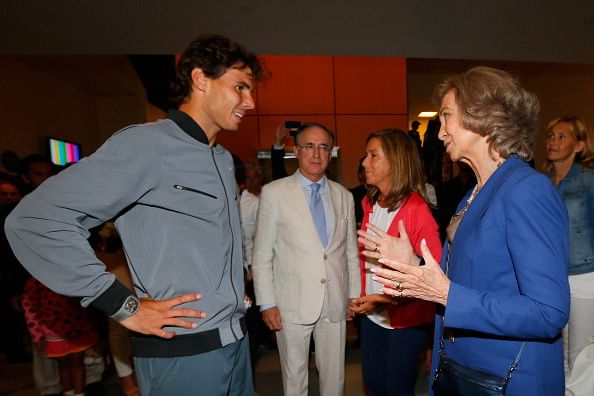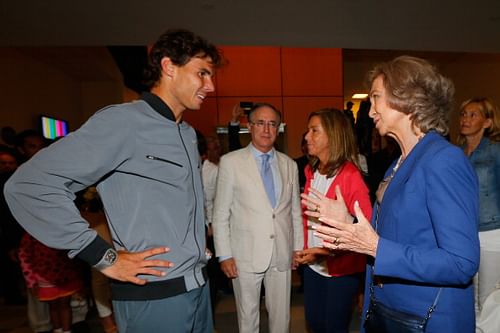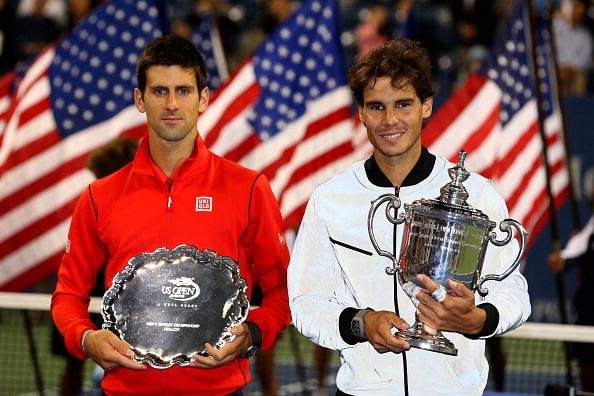
US Open 2013: The crowning of Rafael Nadal, the King of Tennis

If you caught the star presence in the stands inside Arthur Ashe stadium yesterday, you might have mistaken the showpiece event of the night to be a coronation rather than a tennis match.
The who’s who of the celeb world had descended in New York to witness Rafael Nadal battle Novak Djokovic in the US Open men’s singles final – there was football aristocrat David Beckham, TV mogul Martha Stewart, fashion emperor Ralph Lauren, Hollywood superstar Leornado DiCaprio, pop prince Justine Timberlake, drama virtuoso Kevin Spacey, and even Mr. James Bond Sean Connery himself.
The crowning moment, almost literally, came when Queen Sofia of Spain was seen congratulating Nadal after his 6-2, 3-6, 6-4, 6-1 victory. Maybe she should have placed an actual crown on his head while she was at it?
Rafael Nadal rules tennis at the moment. He has always been the King of Clay, but with his unbeaten record on hardcourts in 2013, he has become the King of Hardcourts too. Now that is something that no one – not even his most die-hard of fans – could possibly have imagined when Nadal made took his first tentative steps on the clay courts of Vina del Mar back in February.
It’s an incredible achievement if an athlete can get back to his best immediately after coming back from a career-threatening injury. But playing better than your best just eight months into your comeback? That’s the stuff of legend.
The truly scary part, of course, is that this is actually the second time that Nadal has done something like this – when he underwent an extended injury layoff in 2009, he turned right around and won three Slams in 2010. You can only wonder what unreal height he’ll scale the next time he comes back from an injury.
What makes Nadal’s remarkable run even more impressive is how dramatically it has gone against the script. Forget about his seven-month absence from the tour; even as recently as two months ago, he had people questioning whether he’d ever be able to last through an entire tournament on a fast court, let alone win it.
Nadal’s first-round Wimbledon loss this year was probably the lowest point of his career; it was difficult to look at his dispiriting exit at the ends of the unheralded Steve Darcis in London as anything but a portent of doom. And with his traditional bugbear – hardcourts – up next, the career obituaries (or least his 2013 obituaries) had started being written in earnest.
How do you go from the lowest point of your career to possibly the highest, and that too within a span of two months? How do you destroy a string of long-standing myths through a matter of three tournaments? How do you do the impossible?
It probably helps if you are the human incarnation of Superman.
It also helps if you refuse to ever acknowledge defeat, no matter how many radical changes and adaptations you have to make to your game and mindset.
The prevailing wisdom – which was briefly renounced in 2010, only to resurface again in 2011 – has always been that Nadal’s game is a little too one-dimensional and guerilla-like to ever taste consistent success on hardcourts. But there has always been a way out too: everyone has always known that if Nadal steps into the court, takes the ball on the rise, mixes up his forehand, and shortens the points, his sheer consistency off the ground can outlast even the most powerful of hardcourt specialists.
Nadal had managed to do all of that for brief periods in the past, but had failed to sustain his attacking mindset long enough for him to qualify as a hardcourt specialist; on quick surfaces, a Djokovic would always be the favourite against him. The Spaniard had never been able to keep hugging the baseline day in and day out, because to do that he had to go against his very nature, and play a game that took him far, far away from his comfort zone.
No matter; it may have taken him the better part of a decade, but he has finally done it. He has combined his Superman-like strength and speed with an unyielding willingness to take the attack to the opponent, and the results have been appropriately devastating.
The signs were clearly visible in his triumphs at Montreal and Cincinnati, but it was only in the early stages of his match against Djokovic yesterday that the transformation was truly driven home. Nadal maintained an ultra-aggressive stance, hit his forehand down the line almost as frequently as crosscourt, pushed Djokovic far beyond the baseline with his heavy topspin blasts and, against the best returner in the world, grabbed the set without facing a break point.

The first set was evidence not only of Nadal’s suddenly-potent hardcourt game, but also of his successful conquest of the ‘Djokovic problem’. There was a time when we thought Djokovic owned Nadal not only on the court, but also in his head. After watching yesterday’s match though, it seems that Nadal has not only evicted Djokovic from his head, but also maybe himself taken up residence (if only temporarily) in Djokovic’s head.
In that first set, Nadal’s unusual aggression made Djokovic second-guess himself to the point that the Serb started missing shots that he would’ve normally made in his sleep. Djokovic did find his range by the middle of the second set, because let’s face it, he’s a champion in his own right. And as Djokovic’s shot-making confidence grew, Nadal’s started diminishing a tiny bit.
The Spaniard’s explosive inside-out forehand lost a bit of its sting, and when Djokovic started attacking his backhand wing with abandon, Nadal started resorting to the slice a tad too often. Still, you couldn’t shake the feeling that Djokovic was being forced to absolutely redline his game to wrest the initiative from Nadal, and that kind of relentless, precise power play rarely lasts.
As it turned out, it lasted long enough for the Serb to pocket the second set (which was punctuated by this astonishing 54-shot rally that won Djokovic a break at 3-2), and seriously threaten to take the third. The threat was short-lived, though.
With Nadal serving at 4-4 in the third, Djokovic unleashed a slew of big returns and groundstrokes to earn three break points. Nadal saved the first with a forehand winner, but the second of those break points will probably haunt Djokovic for a long time to come.
Having got stuck into a side-to-side rally, Djokovic seemed in perfect position to strike an inside-out forehand that would end the point in his favour, the way he had ended so many of the points in the set. But he netted the shot instead, and that was all the invitation Nadal needed. The third break point was saved with an ace, which was followed by two more typical Nadal points that helped him hold for 5-4. And before the dazed Serb could probably realize what was happening, he had been broken for the set, and Nadal was up two sets to one.
The fourth set wasn’t as one-sided as the 6-1 score suggests, but the way the errors flowed off Djokovic’s racquet at crucial points in the match suggests that the rivalry may be reverting to its pre-2011 form – when Djokovic perpetually threatened to hit Nadal off the court, but failed to come up with the finishing shot when it mattered most (exhibit A: his flubbed overhead on match point at the 2008 Olympics). But that’s still up for debate; considering the topsy-turvy nature of the Nadal-Djokovic rivalry so far, we may struggle to appropriately define it even if they play another 37 times.
What isn’t up for debate, though, is that Nadal has, for what seems the umpteenth time, silenced his doubters as emphatically as Sheldon Cooper would correct Penny’s faulty grammar. A 22-match winning streak on hardcourts, a 3-match winning streak against his supposed nemesis, 10 titles (with two Slams) in the year and a runaway lead in the year-end rankings race – if it hadn’t been for that anomalous first-round loss in Wimbledon, we may have been tempted to call this the best season of Nadal’s career. And that ship hasn’t exactly sailed yet – if he can win his maiden year-end championship title in London later this year, his 2013 will rank right up there with his stupendous 2010 and his historic 2008.
The last time I thought Nadal had a serious shot at eclipsing Roger Federer‘s record of 17 Slams was when he won the first of his US Open titles in 2010. His latest triumph in New York has brought up the conversation again; only this time, the gap is even narrower. Four Major titles? Two months ago, I’d have said Nadal could win four Slams even if he refused to play anywhere except on clay for the rest of his career. Now, most people will agree that he’ll likely get there even if he refused to play anywhere except on hardcourts for the rest of his career.
The crowds in New York had piled into Arthur Ashe stadium yesterday to witness a tennis match. What they got, instead, was a coronation.
Rafael Nadal, the King of Clay, rules all of tennis, and all those celebs are probably counting their stars they got to see him at his regal best.